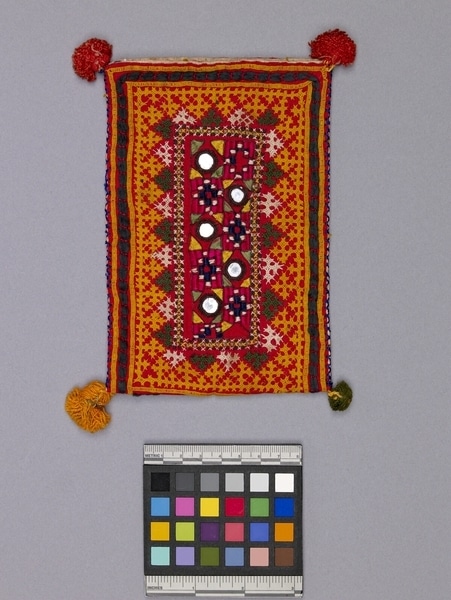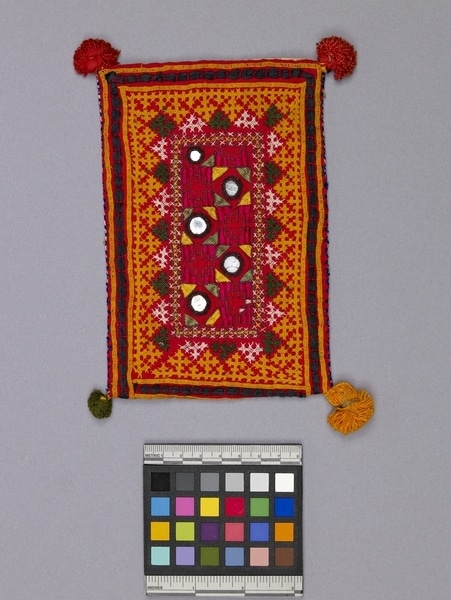Bag Item Number: 1330/3 from the MOA: University of British Columbia


Description
Small, flat, rectangular, multi-coloured pouch made by folding a long, narrow, embroidered panel in half crosswise and stitching up the long sides, leaving one narrow end open. The embroidery is so densely worked that almost none of the background textile is visible. The two sides of the pouch are similar in design and colour, but one side is more heavily embellished than the other. Each side has a rectangular centre design panel embroidered with diamond shaped geometric forms and mirror work; the central panel is surrounded by yellow, green and white motifs worked in detached interlacing stitch. The designs are bordered with rows of yellow square chain stitch and a black “braid” made from dense bundles of black thread that are laid and couched. A tassel made from thread is sewn at each corner. One red glass bead is sewn on one side, at the lower right of the design field. The pouch is lined with off-white cotton muslin.
History Of Use
An example of the way this pouch may have been used is: “A Sorathi Rabari groom uses a small bag called a pothu, one of the very few items his community embroiders, to carry supari (betel nut). Before the ceremony, he distributes supari to guests (in exchange for cash gifts). During the wedding, when he is engaged in rites, the pothu is passed to a ‘best friend’ who has accompanied him from his ness (community).” Frater, 1995, p. 132.
Cultural Context
ceremonial
Specific Techniques
interlacing stitch; cross stitch; satin stitch; buttonhole stitch; couching stitch; double running stitch; square chain stitch
Narrative
Purchased by Milton and Beverly Israel while traveling in India. The embroidery is worked in a combination of kharek style, characterized by clusters of bars of satin stitch, and hurmitch style, characterized by repeated motifs formed from detached interlacing stitch.
Item History
- Made in Gujarat, India ? or Rajasthan, India ? before 1988
- Collected during 1988
- Owned by Milton Israel and Beverly Israel before October 27, 1988
- Received from Milton Israel (Donor) and Beverly Israel (Donor) on October 27, 1988
What
- Name
- Bag
- Identification Number
- 1330/3
- Type of Item
- bag
- Material
- cotton fibre, silk fibre, glass, silver alloy metal ? and dye
- Manufacturing Technique
- embroidered and sewn
- Overall
- height 20.3 cm, width 14.4 cm
Who
- Culture
- Rabari ?
- Previous Owner
- Milton Israel and Beverly Israel
- Received from
- Milton Israel (Donor) and Beverly Israel (Donor)
Where
- Holding Institution
- MOA: University of British Columbia
- Made in
- Gujarat, India ? or Rajasthan, India ?
When
- Creation Date
- before 1988
- Collection Date
- during 1988
- Ownership Date
- before October 27, 1988
- Acquisition Date
- on October 27, 1988
Other
- Item Classes
- textiles
- Condition
- good
- Accession Number
- 1330/0003